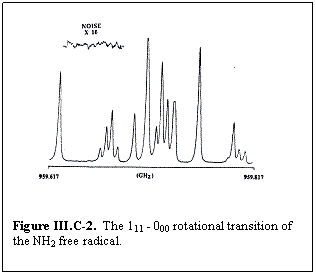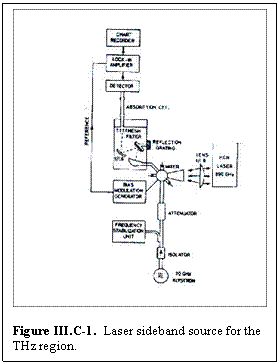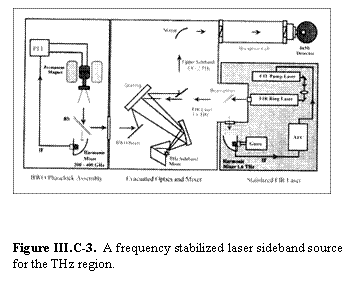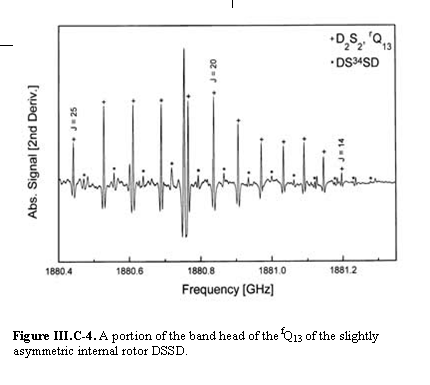
C. Tunable Sideband Sources: The invention of Gas Discharge1 and Optically Pumped Far Infrared Lasers (OPFIR)2 provided relatively powerful sources for the THz region. However, because these are essentially fixed frequency sources, they are of limited spectroscopic use. Schemes based on mixing tunable microwave sources with these lasers have been developed and have proved to be useful in many applications.3-8 (3) (4) (5) (6) (7) ( 8)
Figure III.C-1 shows an example of an early system.3 In it a crossed waveguide harmonic generator was modified to accept drive both from the FIR laser and a sideband generating klystron. A key element in this and similar systems is the passive filtering necessary to separate the relatively weak tunable sideband from the more powerful pump laser. Similar systems have been used for a number of important spectroscopic observations including the study of molecular ions 9, the measurement of dipole moments of molecular ions,10 and the study of weakly bound complexes.11 Figure III.C-2 shows an example of the structure of the 111 - 000 transition of the NH2 free radical near 960 GHz.8 

Because the frequency of the FIR gas lasers can vary with operating conditions by 1 - 5 MHz, for good spectroscopic accuracy provision to stabilize the laser frequency is ordinarily required. A recent example is shown in Figure III.C-3.12 In this system the FIR laser is locked to a reference provided by harmonic mixing a portion of its output with a phase-locked Gunn diode. Tunability is provided in a similar fashion as in the system shown in Fig. III.C-1, except that broader tunability is obtained by the use of a BWO sideband generator. Figure III.C-4 shows an example of the spectra obtained with this system. There exists a powerful alternative to the generation of tunable sidebands from FIR lasers by the electronic methods just described: The tuning of the molecular resonances to the fixed frequencies of the FIR lasers by means of large electric (LER) or magnetic (LMR) fields.13 Although the use of electric fields is more general (essentially all of the species of interest have electric dipole moments, whereas few have significant magnetic moments), the use of magnetic field is much more common. This is largely because LMR is especially well suited to the study of free radical and reactive open shell ions and because the tunability of LER is often relatively small.

11 Because of its fixed frequency and fundamentally more powerful radiation, exquisite sensitivity has been obtained from systems in which these reactive species were contained directly in the FIR
laser cavity. Great complexity of the spectra is often characteristic of the method. Combined with complexity of the theoretical methods required to obtain zero-field frequencies, this has caused the method to be focused on relatively simple species, but often reactive species where its great sensitivity can be used to maximum advantage. A notable example of the application of LER has been the study of van der Waals bonds in the weakly bound Ar-HCl complex.14,15(14) ( 15)

References
[1] H. A. Gebbie, N. W. B. Stone, and J. E. Chamberlain, "A Stimulated Emission Source at 0.34 Millimeter Wave-length," Nature, vol. 202, pp. 685, 1964.
[2] T. Y. Chang and T. J. Bridges, "Laser Action at 452, 496, and 541 µm in Optically Pumped CH3F," Optics Communications, vol. 1, pp. 423-426, 1970.
[3] D. D. Bicanic, B. F. J. Zuidberg, and A. Dymanus, "Generation of continuously tunable laser sidebands in the submillimeter region," Appl. Phys. Lett., vol. 32, pp. 367-369, 1978.
[4] H. R. Fetterman, P. E. Tannenwald, B. J. Clifton, W. D. Fitzgerald, and N. R. Erickson, "Far-ir heterodyne radiometric measurements with quasioptical Schottky diode mixers," Appl. Phys. Lett., vol. 33, pp. 151-154, 1978.
[5] W. A. M. Blumberg, H. R. Fetterman, D. D. Peck, and P. F. Goldsmith, "Tunable submillimeter sources applied to the excited state rotational spectroscopy and kinetics of CH3F," Appl. Phys. Lett., vol. 35, pp. 582-585, 1979.
[6] J. Farhoomand, G. A. Blake, M. A. Frerking, and H. M. Pickett, "Generation of tunable laser sidebands in the far-infrared region," J. Appl. Phys., vol. 57, pp. 1763-1768, 1985.
[7] P. Verhoeve, E. Zwart, M. Versluis, J. ter Meulen, W. L. Meerts, A. Dymanus, and D. Mclay, "A far infrared laser sideband spectrometer in the frequency region 550 - 2700 GHz," Rev. Sci. Instrum., vol. 61, pp. 1612-1625, 1990.
[8] G. A. Blake, K. B. Laughlin, R. C. Cohen, K. L. Busarow, D.-H. Gwo, C. A. Schmuttenmaer, D. W. Steyert, and R. J. Saykally, "Tunable Far Infrared Laser Spectrometers," Rev. Sci. Instruments, vol. 62, pp. 1693-1700, 1991.
[9] F. C. van den Heuvel and A. Dynamus, "Observation of Far-Infrared Transitions of HCO+, CO+, and NH2+," Chem. Phys. Lett., vol. 92, pp. 219-222, 1982.
[10] K. B. Laughlin, G. A. Blake, R. C. Cohen, D. C. Hovde, and R. J. Saykally, "Determination of the Dipole Moment of ArH+ from the Rotational Zeeman Effect by Tunable Far-Infrared Laser Spectroscopy," Phys. Rev. Lett., vol. 58, pp. 996-999, 1987.
[11] K. L. Busarow, G. A. Blake, K. B. Laughlin, R. C. Cohen, Y. T. Lee, and R. J. Saykally, "Tunable Far-Infrared Laser Spectroscopy in a Planar Supersonic Jet: The S Bending Vibrations of Ar-H35Cl," Chem. Phys. Lett., vol. 141, pp. 289-291, 1987.
[12] R. Gendriesch, F. Lewen, G. Winnewisser, and J. Hahn, "Precision Broadband Spectroscopy near 2 THz: Frequency-Stabilized Laser Sideband Spectrometer with Backward-Wave Oscillators," J. Mol. Spectrosc., vol. 203, pp. 205-207, 2000.
[13] K. M. Evenson, R. J. Saykally, D. A. Jennings, R. F. Curl, and J. M. Brown, Far Infrared Laser Magnetic Resonance, vol. V. New York: Academic, 1980.
[14] M. D. Marshall, A. Charo, H. O. Leung, and W. Klemperer, "Characterization of the lowest-lying P bending state of Ar-HCl by far infrared laser-Stark spectroscopy and molecular beam electric resonance," J. Chem. Phys., vol. 83, pp. 4924-4933, 1985.
[15] R. J. Saykally, "Far-Infrared Laser Spectroscopy of van der Waals Bonds: A Powerful New Probe of Intermolecular Forces," Accts. Chem. Res., vol. 22, pp. 295-300, 1989.
Back to Millimeter and Submillimeter Techniques page